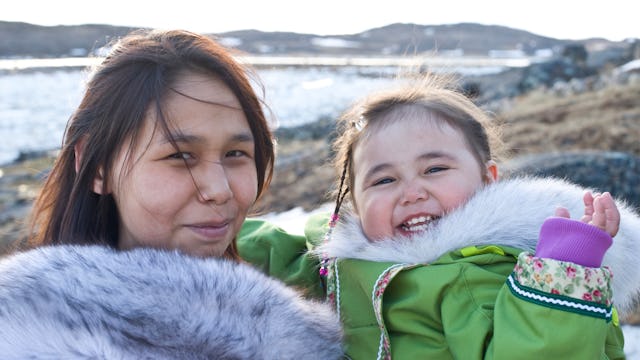Inuit Parents Have A Unique -- And Calm -- Approach To Parenting

From a friend, I learned about the idea of giving my kids “invisible trophies.” If they do something particularly good or wonderful or difficult, I give them an invisible trophy. I may talk about its particular attractiveness or beauty or what’s written in gold on it. Only mom and dad have this secret power, so they can’t go manufacturing these treasures on their own. They giggle and gladly accept it. They will walk to the moon and back for these invisible trophies — including my nine-year-old.
It’s a form of storytelling, in a way, a kind of play-modeling that reinforces good behavior. Psychologist Deena Weisberg at Villanova University told NPR, “Stories, by their nature, can have lots of things in them that are much more interesting in a way that bare statements don’t.” The Inuit have known this. And that’s perhaps why they use stories to teach their children: teach them not only discipline in general, but also how to control their anger.
RELATED: Tips And Tactics For Effectively Disciplining Your Toddler
The Inuit according to Inuulitsivik, the Canadian Inuit site, are “the aboriginal inhabitants of the North American Arctic” and though spread throughout the Arctic Circle, number about 40,000 in Canada and 16,500 in the US. In the Inuit culture, “Control of anger, or hostile emotion of any kind, is an imperative … Accidents, inept behavior, and failures result only in murmurs or gentle laughter—people impose strong self-control on their emotions,” says Inuit of Utkuhikhalik and Qipisa Communities.
Showing any sign of anger is seen as babyish, weak, foolish. Jean Briggs, a Harvard grad student who lived with the Inuit for 17 months in the 1970s, told the Canadian Broadcasting Corporation, according to NPR, that no one ever showed anger towards her, “though they were angry with me an awful lot.”
First, the Inuit are among the gentlest parenting cultures in the world. They rarely, if ever, yell at a child. In his book Inuit Youth: Growth and Change in the American Arctic, Richard Guy Condon says that he heard of only one substantiated case of physical punishment in three years of fieldwork, and that “a child who misbehaves is not seen as a ‘bad child,’ who intentionally engages in culpable acts, but as a child who ‘really can’t listen.’” As Learn Alberta says, “Slapping and scolding were not regarded as acceptable forms of child control.”
Inuit elders who spoke with NPR laughed at the idea of yelling at or scolding a small child. “It will just make your own heart rate go up,” says one woman. When little kids do something anti-social, “They’re upset about something, and you have to figure out what it is.”
Yelling at a kid is demeaning: it means you’re becoming the child and throwing the tantrum yourself. Moreover, “You are teaching them to be angry,” clinical psychologist and author Laura Markham said to NPR.
Well, damn. That’s a different approach than the yelling, spanking, time-out, say-you’re-sorry Western culture we are immersed in.
Instead, they use storytelling to modify behavior. When children misbehave, everyone waits until the children have calmed down — really calmed down — from the situation. They have to be in the right frame of mind for the lesson to work. Then the parents reenact the scene. The kid is “tempted to misbehave,” according to NPR. And the parents will respond by saying things like, “Don’t you like me?” or “Ow that hurts!” or “Are you a baby?” The Harvard graduate student says that she once saw a mother hand a pebble to a child. “Hit me! Go on. Hit me harder,'” she encouraged him. “OW! That hurts!” she said.
That sounds like something out of Brad Pitt’s Fight Club: “I want you to hit me as hard as you can!” not a typical mother-child interaction. But she says kids learn to emotionally regulate this way — they practice controlling their anger at the situation, and they learn the proper response to the behavior. All through play. It’s a beautiful system. As Markham says, “Play is their work. It’s about how they learn about their world and about their experiences.”
But this storytelling goes even beyond play-acting, into storytelling that might horrify some Western parents. Want to keep your kid away from the ocean? Don’t scold. Tell them a sea monster lives there who will stick them in its pouch and spirit them away to another family. Absolute terror, but it works. It keeps them safe from very real danger. Want them to keep their hat on? The northern lights will snatch their heads off. “We were so scared,” giggles one Inuit girl. But it keeps the kids in line, and teaches them to behave according to Inuit cultural norms, says NPR. Like my invisible trophies, they teach kids a story that enforces good behavior.
While you may not agree with the sea monsters, waiting until both parent and child are calm to respond helps kids learn emotional regulation in a safe, calm manner.
This is nothing short of brilliant.
In our family, I think we’re going to move beyond invisible trophies and into actual storytelling about bad behavior. I’m past the small child where we can recreate situations with dolls (rich fodder for the very young), but that doesn’t mean I can’t utilize some of the other Inuit techniques. My boys could definitely use some help practicing self-control.
Maybe this could help.
Maybe this could teach them some self-regulation and appropriate coping mechanisms. It can certainly help me to regulate my own emotions before I react to my children’s behavior.
So, maybe I’ll give this a shot. At the very least, Inuit parenting sounds a hell of a lot better than ineffectively screaming my lungs out.
This article was originally published on